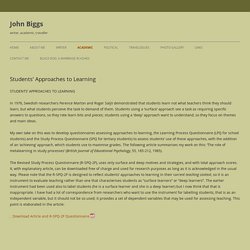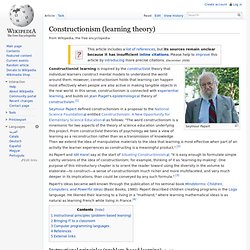

Collapsed Topics course format new structure. Moodle structural overview. "Teaching Teaching & Understanding Understanding" (2/3) [English subtitles] "Teaching Teaching & Understanding Understanding" (1/3) [English subtitles] SOLO taxonomy. I am pleased to say that John Biggs himself has endorsed this representation of his ideas; "I've just found your website on SOLO et al. via google.

I'm delighted! Your diagrams of prestructural-extended abstract are very elegant... " (Unsolicited email, 29 May 2005) The SOLO taxonomy stands for: Structure of Observed Learning Outcomes It describes level of increasing complexity in a student's understanding of a subject, through five stages, and it is claimed to be applicable to any subject area. I confess to a slight distrust of this kind of "progressive" model, which aspires inexorably to a final state. However, the emerging field of work on Threshold Concepts and Troublesome Knowledge links in very effectively with the SOLO taxonomy and offers some points about how the above issues might be addressed. There is a small but enthusiastic group of teachers using the SOLO taxonomy to structure their teaching in schools, and blogging about it.
Www.heacademy.ac.uk/assets/documents/resources/database/id477_aligning_teaching_for_constructing_learning.pdf. Students’ Approaches to Learning. In 1976, Swedish researchers Ference Marton and Roger Saljö demonstrated that students learn not what teachers think they should learn, but what students perceive the task to demand of them.

Students using a ‘surface’ approach see a task as requiring specific answers to questions, so they rote learn bits and pieces; students using a ‘deep’ approach want to understand, so they focus on themes and main ideas. My own take on this was to develop questionnaires assessing approaches to learning, the Learning Process Questionnaire (LPQ for school students) and the Study Process Questionnaire (SPQ for tertiary students) to assess students’ use of these approaches, with the addition of an ‘achieving’ approach, which students use to maximise grades. The following article summarises my work on this: ‘The role of metalearning in study processes’ (British Journal of Educational Psychology, 55, 185-212, 1985). Download Article and R-SPQ-2F Questionnaire. Www.floridatechnet.org/inservice/abe/abestudent/andravsped.pdf. Learning.media.mit.edu/content/publications/EA.Piaget _ Papert.pdf.
Learning Theories of Instructional Design. Constructivism vs. Constructivism vs. Constructionism. Constructivism vs.

Constructivism vs. Constructionism Notes by Mark Guzdial I'd like to offer my take on the meaning of these words. I hear them used in so many ways that I often get confused what others mean by them. Constructivism, the cognitive theory, was invented by Jean Piaget. I don't know who invented the notion of Constructivism, the educational philosophy, but it says that each students constructs their own, unique meaning for everything that is learned. From my perspective, the assumption of constructivists is currently an untestable hypothesis. Www.lindenwood.edu/education/andragogy/andragogy/2011/Fidishun_2005.pdf. Constructionism (learning theory) Seymour Papert Seymour Papert defined constructionism in a proposal to the National Science Foundation entitled Constructionism: A New Opportunity for Elementary Science Education as follows: "The word constructionism is a mnemonic for two aspects of the theory of science education underlying this project.

From constructivist theories of psychology we take a view of learning as a reconstruction rather than as a transmission of knowledge. Then we extend the idea of manipulative materials to the idea that learning is most effective when part of an activity the learner experiences as constructing is a meaningful product. ".[2] Principles of Constructionism. George Towner April 2012 The term “constructionism” was introduced in Papert’s system of pedagogy, based on Piaget’s concept of constructivism in human learning.

It has also been applied to Berger and Luckmann’s description of social construction. In my usage, constructionism is an ontological theory that describes how life constructs reality so living organisms can know it. Constructionism, as developed in The Reality of Knowledge, is based on seven principles: Constructivism. Learning.media.mit.edu/content/publications/EA.Piaget _ Papert.pdf.
Situating Constructionism. By Seymour Papert and Idit Harel The following essay is the first chapter in Seymour Papert and Idit Harel's book Constructionism (Ablex Publishing Corporation, 1991).

It is easy enough to formulate simple catchy versions of the idea of constructionism; for example, thinking of it as "learning-by-making. " One purpose of this introductory chapter is to orient the reader toward using the diversity in the volume to elaborate--to construct--a sense of constructionism much richer and more multifaceted, and very much deeper in its implications, than could be conveyed by any such formula. My little play on the words construct and constructionism already hints at two of these multiple facets--one seemingly "serious" and one seemingly "playful.
" The serious facet will be familiar to psychologists as a tenet of the kindred, but less specific, family of psychological theories that call themselves contructivist. They are not the only ones who are so predisposed. Footnotes References. Situating Constructionism.